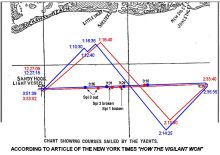 The Valkyrie, with her jib set and her mainsail up, but sagging at the throat, was going down the west bank in tow of the tug Pulver, while the Vigilant, under main sail, was horsing down the Swash Channel, near the bar, with the tug Commander puffing laboriously behind. After the Valkyrie entered the Swash the crew lined on the port side from the mast aft to jigger up to mainsail, but before the all was made to set some trouble was discovered and two men were sent aloft. They fumbled awhile and unlashed something. The Valkyrie, with her jib set and her mainsail up, but sagging at the throat, was going down the west bank in tow of the tug Pulver, while the Vigilant, under main sail, was horsing down the Swash Channel, near the bar, with the tug Commander puffing laboriously behind. After the Valkyrie entered the Swash the crew lined on the port side from the mast aft to jigger up to mainsail, but before the all was made to set some trouble was discovered and two men were sent aloft. They fumbled awhile and unlashed something. 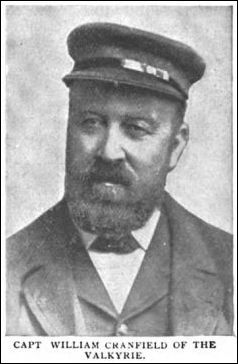 Then Capt. Cranfield went aloft himself, and when he descended the sail came down. Then one of the men brought down the throat halyard block, and Capt. Cranfield and several of his men tinkered with it on deck for a long time, while Lord Dunraven stood craning his neck over their heads. Then Capt. Cranfield went aloft himself, and when he descended the sail came down. Then one of the men brought down the throat halyard block, and Capt. Cranfield and several of his men tinkered with it on deck for a long time, while Lord Dunraven stood craning his neck over their heads.
In answer to a question asked by a reporter for The New-York Times, Capt. Cranfield said there was something wrong with the block, but the trouble could be remedied.
There were fewer guests than usual on the Valkyrie. Lord Dunraven's daughters were not there, and besides the pilot, Martin Lyons, the only notables were H. Maitland Kersey, Lord Wolverton, and Vice Commodore Archibald Rogers.
While the Valkyrie was in trouble in the Swash the Vigiiant was away to the southward of the lightship. Upon her deck were noticed C. Oliver lselin, Perry Belmont, Charles Kerr, Herbert Leeds, Dr. XV. Barton Hopkins, Edward A. Willard, W. Butler Duncan, Jr., Nat Herreshoff, and Capts. Terry and Hansen. Seeing the Valkyrie drop her mainsail, the Vigilant people, who were too far away to see just what was going on, concluded that she was going to put in a reef, and promptly put in a single reef themselves. There was no occasion for it at the tune, but they probably anticipated wind enough later to justify it.
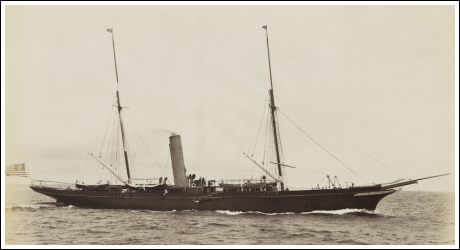
At 11:05 the flagship May took a position north of the lightship, and displayed the signals D- C- B., which indicated that the course would be east. At 11:15 the tug Edgar F. Luckenback was sent off to log the course, and ten minutes later the May sent aloft the red ball, which meant that the time for the start had arrived.  However, as the Valkyrie was just then hoisting her mainsail fully three miles away, the signals C. G. were set to announce that the start would be postponed until she was ready. The Vigilant, which had gone away off to the northeast, evidently mistook the signals for similar ones which meant "Race postponed on account of fog," and after much wigwagging between herself and the flagship, the tug Luckenback was sent off to explain away the misunderstanding. The Valkyrie having finally got ready, the preliminary signal was run up to the truck of the May‘s foremast at 12:07, and the preparatory signal was given ten minutes later. However, as the Valkyrie was just then hoisting her mainsail fully three miles away, the signals C. G. were set to announce that the start would be postponed until she was ready. The Vigilant, which had gone away off to the northeast, evidently mistook the signals for similar ones which meant "Race postponed on account of fog," and after much wigwagging between herself and the flagship, the tug Luckenback was sent off to explain away the misunderstanding. The Valkyrie having finally got ready, the preliminary signal was run up to the truck of the May‘s foremast at 12:07, and the preparatory signal was given ten minutes later.
 When the Valkyrie came close it was discovered that she had followed the example of the Vigilant and put a single reef in her mainsail, but it was a very small reef compared with that of the Vigilant, hardly more than one-fourth the size. She had also set a smaller jib than that which she flew coming down the bay. Both yachts carried gaff topsails, the Valkyrie had a sprit at the head, and both were without jibtopsails. Indeed, there was no need to woo the breeze, for it was coming out of the east at a twenty-knot gait. When the Valkyrie came close it was discovered that she had followed the example of the Vigilant and put a single reef in her mainsail, but it was a very small reef compared with that of the Vigilant, hardly more than one-fourth the size. She had also set a smaller jib than that which she flew coming down the bay. Both yachts carried gaff topsails, the Valkyrie had a sprit at the head, and both were without jibtopsails. Indeed, there was no need to woo the breeze, for it was coming out of the east at a twenty-knot gait.
The boom of the gun at 12:17 o'clock from the flagship May could hardly be heard, the wind drowning the sound, but the red ball run up on the maintopmast stay gave the signal for the yachts to prepare. The yachts were then both on the starboard tack. The Valkyrie was headed for the lightship, and the Vigilant was further in shore, heading about northeast. For a moment the vigilant lay in the wind and then the Valkyrie went about and stood over toward her. She crossed her bows, went down to windward of her, and then, jibing prettily, came up again on the weather quarter.

The Vigilant made a sharp lurch to keep ahead of the Valkyrie, but Capt. Cranfield luffed his boat and still held the weather position. Then, giving her plenty of sheet, he ran across the Vigilant’s bows, and for a while the Vigilant held the weather position. The Valkyrie again stood inshore, and then, going about, stood for the Lightship end of the line. The Vigilant, in the meantime, had stood right down to the crossing line, and it was evident that either Nat Herreshoff or Capt. Cranfield had miscalculated.

On they came, and it was a question whether the Vigilant would not have to go about again, or cross the line before the gun. At 12:27 the starting signal was given and about ten seconds later the Valkyrie shot over the line, while the Vigilant had to make half a board to weather the flagship. Both yachts were then on the starboard tack, pointing northeast by east. The Valkyrie held the weather position. She was about 100 yards to windward of the Vigilant, and again Capt. Cranfield had out-maneuvered Nat Herreshoff of the Yankee boat.
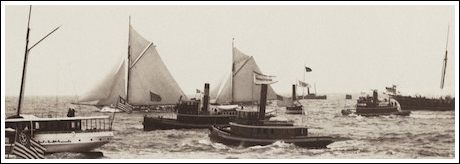
The wind now was blowing about twenty miles an hour and was increasing in force every minute. The whitecaps that appeared early in the morning had blown into good-sized waves, that were hurrying and scurrying along toward the shore and, in their eagerness to get there, tumbling over one another, throwing their spray hither and thither and making things unpleasant for everybody except lovers of a yacht race. It was a breeze such as Lord Dunraven had been wanting, a breeze with plenty of sea accompanying it, and one that would thoroughly test the merits of the yachts.

The Valkyrie seemed to be a trifle stiffer than the white Yankee boat and her sharp nose cut through the water easily. She pointed high, too, and at the start renewed the tactics of the previous races by seeming to draw ahead. This, by the onlookers, was regarded as part of the customary program. It was expected that the Valkyrie would lead for a while, in order to make things somewhat interesting, and then that the Vigilant would go to the front and settle the question of superiority beyond a doubt.
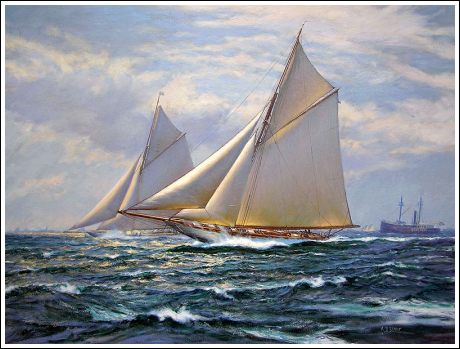
The Vigilant pounded considerably on the waves and threw big mountains of spray on either side of her bow. She dropped down to leeward of the English boat, but as soon as she was across the line commenced to foot fast. About fifteen minutes after the start the wind hauled a point to the southward. The Valkyrie was sailing about four points off the wind and three points off the course. She was pointed high, much higher than the white boat, but the Vigilant had forereached on her, and, although to leeward, was well in the lead.

At 12:45 o'clock, the Valkyrie was at least 200 yards to windward of the Vigilant and every minute she was making this gap wider. The wind was still breezing. The waves were looking angrier. The barometer was falling fast, and out to the eastward it looked dark and lowering. The waves seemed to glance off the bows of the Valkyrie, but they came against the Vigilant with a thud and the spray was tossed up in the air and fell down on the deck, drenching every one.
The Valkyrie’s decks were by no means dry, but she was making better weather of it than the Vigilant. The waves were setting the Vigilant down to leeward, and she seemed to be sailing against the Valkyrie just as the Colonia had sailed against her in the trial races. Nat Herreshoff gave her one or two sharp lufs, but was unable to hold on the same course as the Valkyrie.

At 1 o'clock the gap between them had been increased to about a third of a mile, but the Vigilant had forereached so far ahead that when she went about on the other tack it appeared as though she would come very close to the English boat.
The wind was now nearly twenty-five miles an hour. It was whistling through the rigging on the excursion steamers in an angry way. The yachts were standing on toward Long Beach, and the big hotels and Summer cottages were looming up prominently ahead. At 1:10:30 the Vigilant went on the port tack and stood over toward the Valkyrie. She rapidly drew near the English boat, but at 1:12:40 Nat Herreshoff, seeing that he was unable to cross the Valkyrie’s bow, put her about again, and both stood on toward the beach. The Vigilant began sagging again and she was given a sharp luff to get a better hold on the wind.
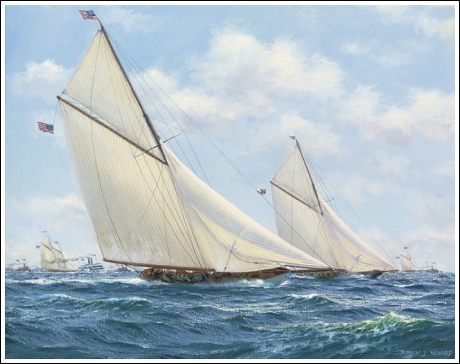
The Valkyrie now began to outfoot the Vigilant in addition to eating out to windward of her. At 1:16:35 the Vigilant went about on, the port tack, and five seconds later the Valkyrie spun around on her heel. The English boat was now about a hundred yards ahead, and a hundred yards to windward of the Vigilant. They had been racing for more than three-quarters of an hour, and the difference between the two boats was hardly perceptible. In a wind blowing like that at the time it was only a question of a few seconds. The Vigilant was now in a bad position. She was to leeward and astern, and the Valkyrie was breaking her wind so that her headsails flapped. Nat Herreshoff gave the Vigilant a rap full in order to try and draw out through the Valkyrie’s lee. The Vigilant was heading south-southeast, and the Valkyrie was sailing a quarter of a point better.

It was a grand contest. The yachts flew through the water. The foam boiled and seethed around their sides, and the spindrift was thrown over their decks, wetting everything. The men were all crouched down to windward, and the sails were as stiff as boards, every inch drawn. The Valkyrie was slipping through the water faster than the Vigilant, the great beam of the American boat evidently retarding her. At 1:25 the Valkyrie had increased her lead to 200 yards, and had worked about the same distance to windward of the white boat.
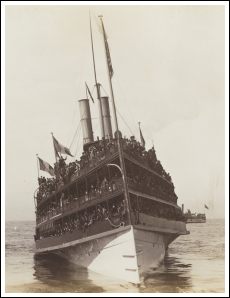 “John is beating the tar out of the Yank," said skipper Henderson of the tugboat Kate Jones, on board of which were The Times men. The seas were playing a merry game with the tugs and excursion steamers out; they were tossing them about, breaking over their decks, and making things generally unpleasant for all on board. The Kate Jones, however, was making good weather of it. She went through the water as steadily as an ocean steamer, and easily kept up with the excursion racers, leaving many of the tugs and excursion steamers behind. “John is beating the tar out of the Yank," said skipper Henderson of the tugboat Kate Jones, on board of which were The Times men. The seas were playing a merry game with the tugs and excursion steamers out; they were tossing them about, breaking over their decks, and making things generally unpleasant for all on board. The Kate Jones, however, was making good weather of it. She went through the water as steadily as an ocean steamer, and easily kept up with the excursion racers, leaving many of the tugs and excursion steamers behind.
The yachts were now tearing through the water. The Valkyrie was ahead and dead to windward of the Vigilant. The Vigilant would seem to gain a little and then fall back. The yachts were sailed to perfection. One little slip on either would have put her hopelessly out of the race. The strain on the spars and rigging was enormous, and if one little rope yarn had parted on either boat that boat would have been badly beaten. At 2 o'clock the Valkyrie seemed to shoot ahead. The harder it blew and the heavier the seas, the better she seemed to like it.  |
|
The turning point was plainly in sight on the port bows of the yachts. It looked as though both could fetch, but each was waiting for the other to tack first. The Valkyrie would not go about, because she did not want to let the Vigilant work to windward of her, and the Vigilant would not go about, because those on board did not want to tack under the Valkyrie's stern.

The Valkyrie was the first to break tacks. She went about at 2:13:30 and headed for the mark. The Vigilant stood on for fifty-five seconds longer, until she got across the Valkyrie's wake, and then she went on the starboard tack. The Valkyrie was now a third of a mile ahead. They were heading northeast. The stakeboat was to the leeward of both of them, and both were given a rap full.
The Vigilant was given a little more sheet than the Valkyrie, but the English boat was rapidly working to windward of the Yankee. In previous races Lord Dunraven and Mr. Watson have had rare opportunities to admire the beauties of the Vigilant's stern, but in yesterday's race Nat Herreshoff had a chance to study the beauties of the after body of the Watson creation.
 At 2:33:10 the Valkyrie went on the port tack to round the mark, and at 2:33:40 she rounded, and, easing off her main boom to starboard, pointed for home. At 2:35 the Vigilant tacked to round the stake, and at 2:35:35 she went around. The Valkyrie had made the fifteen-mile beat to windward in 2:06:40, while the Vigilant's time was2:08:35, so that the Valkyrie beat the Vigilant 1:55. At 2:33:10 the Valkyrie went on the port tack to round the mark, and at 2:33:40 she rounded, and, easing off her main boom to starboard, pointed for home. At 2:35 the Vigilant tacked to round the stake, and at 2:35:35 she went around. The Valkyrie had made the fifteen-mile beat to windward in 2:06:40, while the Vigilant's time was2:08:35, so that the Valkyrie beat the Vigilant 1:55.
 This was a surprise to everybody. It was the first time in the history of the America's Cup that an English cutter had got the best of an American centreboard in a dead thrash to windward and in a hard blow. When the Valkyrie rounded she had to luff off her course to keep out of the Vigilant's way, but as soon as the Vigilant had passed she sent out her spinnaker pole to port, and set the spinnaker at 2:35:50. At 2:45 she sent up her big jib topsail, and just before that she set her balloon staysail. This was a surprise to everybody. It was the first time in the history of the America's Cup that an English cutter had got the best of an American centreboard in a dead thrash to windward and in a hard blow. When the Valkyrie rounded she had to luff off her course to keep out of the Vigilant's way, but as soon as the Vigilant had passed she sent out her spinnaker pole to port, and set the spinnaker at 2:35:50. At 2:45 she sent up her big jib topsail, and just before that she set her balloon staysail.![Valkyrie II [and] Vigilant, turning mark in last race - John S. Johnston 01062S2.jpg](/images/stories/1893/01062S2.jpg) The Vigilant set her spinnaker at 2:40:30, and as soon as it was broken out it looked as though it would tear away from the yacht. It seemed to get away from the men who were sheeting it home, and the spinnaker pole buckled under the strain. Before setting the spinnaker she had shaken out the reef in her mainsail, and then sent up her big club topsail. At 2:59:30 the big balloon jib topsail was broken out, and then she was staggering home under every stitch of canvas that she could carry. It was a grand sight to see this grand boat plowing through the water with every stitch of her thousands of feet of canvas drawing well. It was a sight that must have made the veriest landlubber on any of the excursion steamers out there enthuse. The strain on her topmast must have been enormous, and some of the timid ones began to think that she would carry away something and that then she would be put hopelessly out of the contest. The Vigilant set her spinnaker at 2:40:30, and as soon as it was broken out it looked as though it would tear away from the yacht. It seemed to get away from the men who were sheeting it home, and the spinnaker pole buckled under the strain. Before setting the spinnaker she had shaken out the reef in her mainsail, and then sent up her big club topsail. At 2:59:30 the big balloon jib topsail was broken out, and then she was staggering home under every stitch of canvas that she could carry. It was a grand sight to see this grand boat plowing through the water with every stitch of her thousands of feet of canvas drawing well. It was a sight that must have made the veriest landlubber on any of the excursion steamers out there enthuse. The strain on her topmast must have been enormous, and some of the timid ones began to think that she would carry away something and that then she would be put hopelessly out of the contest.

A stern chase is a long chase, and those on the Vigilant realized that something had to be done to cut down the 1 minute and 55 seconds gained by the Valkyrie, and in addition to this to make up the 1 minute and 33 seconds which she had to allow the English boat, altogether 3 minutes and 28 seconds. As soon as she got her big kite spread she made a perceptible gain on the English boat, and by 3:10 was astern of the Valkyrie and breaking the Englishman's wind badly. At 3:12 the Valkyrie took in her balloon staysail. It was burying her too much.

The yachts were now scarcely 300 yards apart, and were flying through the water at the rate of almost 12 knots an hour. The Vigilant would luff astern of the Valkyrie, and. breaking his wind, crawl up on him. Then the Valkyrie would luff out, and, getting the wind freely again, dart ahead. Again the Vigilant would get astern the Valkyrie and take her wind, and every time she did so the big spinnaker and the big jib topsail would back and hang like rags. Then she would get out and get the wind free again, and with a plunge, and with every strip of canvas drawing, shoot on toward the red lightship many miles ahead.
It was nip and tuck between the yachts. The Vigilant could crawl up, but could not pass the Englishman. It looked as though the Valkyrie must win the race, for if the Vigilant did get ahead, and with the Valkyrie astern taking her wind, it seemed hardly probable that she would draw far enough ahead to save the time allowance.

At 3:25 the Valkyrie’s spinnaker backed through the Vigilant taking her wind. The inner leach of the spinnaker caught on the spreader, and when it filled out again it was seen there was a tiny tear in it. Every puff of wind that now came into the sail made this tear bigger and bigger, and it was only a question of a few minutes when it would be right across the sail.
It was hard luck. The Valkyrie seemed to have victory in her hand. True, it would be only one of the series of races, but very few Americans begrudged the Englishman one race after the plucky fight he had made for the cup. While they would give him one race, they would strenuously object to his winning three.
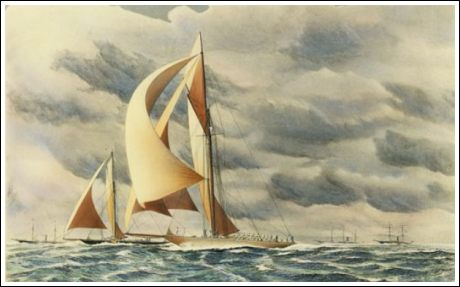
At 3:29 the Valkyrie took in her torn spinnaker and as she did so the Vigilant went by her, taking the lead for the first time in the race. She was greeted with cheers and whistles as she went to the front, but the Valkyrie was not beaten yet. The lightship was in plain sight, and the Vigilant had to get 1 minute and 33 seconds ahead. Crippled as he was, the Englishman was not going to give up the fight and at 3:31 the light Irish linen spinnaker was sent out. This is the one that was used in light weather days, the one that called forth so much admiration. Just as it was hauled outboard a strong puff of wind ripped it from the foot to the top as though it were made only of tinder. It hung there in ribbons, one half flapping outboard and the other half getting foul of the jib topsail.

It was another piece of hard luck, and in the meantime the Vigilant was fast crawling ahead. She had opened up a gap between the two boats now, and in five minutes had snatched victory from the Valkyrie, for which the black boat had been fighting for more than three hours. The crew on the disabled boat worked like beavers. They hauled in the shreds of the old spinnaker, and at 3:35 broke out another, an as soon as it was sheeted home she tore through the water after the white boat, which was now well in the lead. As she broke out the third spinnaker those on the excursion steamers nearby cheered lustily for her pluck and for the beautiful way in which her crew had worked.

“ How many spinnakers do they carry on that boat" asked one yachtsman. “Does Lord Dunraven buy them by the dozen, as he would towels?"
The third spinnaker set was the balloon jibtopsail which she had used when reaching in light weather. The wind was blowing harder than ever. Its force was somewhere between thirty and thirty-five miles. The Valkyrie was carrying the freshening breeze along with her, and it seemed as though she was gaining a trifle on the Vigilant.
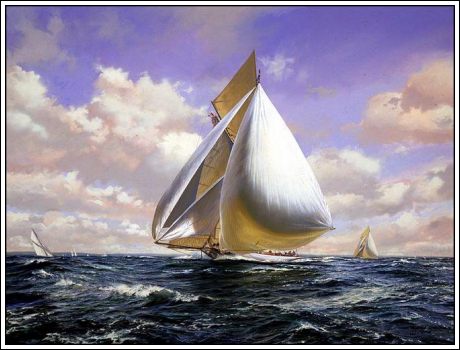
The Vigilant's topmast was buckling under the enormous strain, and if an accident should happen to her the Valkyrie would certainly win.
Would she stand for ten minutes longer and keep the America's Cup here without another contest, or would the Valkyrie get one race out of the series? That was the question everybody was asking.
On they tore toward the lightship. They seemed to literally fly through the water, and everybody watched the boats with intense excitement. The May, the flagship, had anchored at the finish. She was only able to beat the racers back to the line.
![VIGILANT [sailing yacht] winning the race - August Loeffler 01425S2.jpg](/images/stories/1893/01425S2.jpg) At 3:51:39 the Vigilant shot over the line. She was saluted by all the steamers that had managed to get back to the finish, but there was no enthusiastic cheering as there had been on previous days, because it was doubtful if she had won the race. At 3:51:39 the Vigilant shot over the line. She was saluted by all the steamers that had managed to get back to the finish, but there was no enthusiastic cheering as there had been on previous days, because it was doubtful if she had won the race.
The Valkyrie was coming down like a racehorse. She seemed to cut off big chunks of the gap between her and the finishing line every second. Everyone was counting the time. The seconds seemed to be minutes; they would not go fast enough for the patriotic American yachtsman. To the English the minutes seemed to be seconds, and the minute and thirty-three seconds disappeared all too quickly and the yacht was not over the line. The Valkyrie crossed at 3:53:52. It took but a minute for the Regatta Committee to figure out the winner, and the red-and-black pennant of the Vigilant was run up on the main topmast stay, and then pandemonium broke loose. Every one cheered. Hats were waved and whistles tooted, and many in their excitement danced and threw their hats in the air and, miscalculating the force of the wind, lost them overboard.
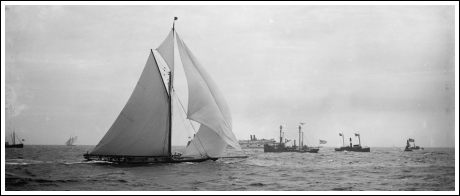
The Valkyrie crossed at 3:53:52. It took but a minute for the Regatta Committee to figure out the winner, and the red-and-black pennant of the Vigilant was run up on the main topmast stay, and then pandemonium broke loose. Every one cheered. Hats were waved and whistles tooted, and many in their excitement danced and threw their hats in the air and, miscalculating the force of the wind, lost them overboard.
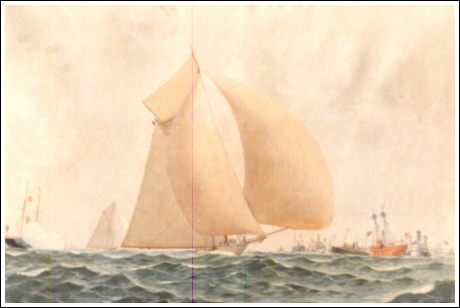
The following table tells the story of the race at a glance:
| |
Start. |
Finish. |
Actual
Time. |
Corrected
Time. |
| |
H. |
M. |
S. |
H. |
M. |
S. |
H. |
M. |
S. |
H. |
M. |
S. |
| Vigilant |
12 |
27 |
00 |
3 |
51 |
39 |
3 |
24 |
39 |
3 |
24 |
39 |
| Valkyrie |
12 |
27 |
00 |
3 |
53 |
52 |
3 |
26 |
52 |
3 |
25 |
19 |
The following tables show the elapsed time for each yacht over each leg of the course:
From the start to the outer mark:
| |
Start. |
Mark. |
Actual
Time. |
Gains. |
| |
H. |
M. |
S. |
H. |
M. |
S. |
H. |
M. |
S. |
H. |
M. |
S. |
| Vigilant |
12 |
27 |
00 |
2 |
35 |
35 |
2 |
08 |
35 |
.. |
.. |
.. |
| Valkyrie |
12 |
27 |
00 |
2 |
33 |
40 |
2 |
06 |
40 |
.. |
.1 |
55 |
From the outer mark to the finish::
| |
Mark. |
Finish. |
Actual
Time. |
Gains. |
| |
H. |
M. |
S. |
H. |
M. |
S. |
H. |
M. |
S. |
H. |
M. |
S. |
| Vigilant |
2 |
35 |
35 |
3 |
51 |
39 |
1 |
16 |
04 |
0 |
04 |
08 |
| Valkyrie |
2 |
33 |
40 |
3 |
53 |
52 |
1 |
20 |
12 |
.. |
.. |
.. |
In the beat to windward, the Valkyrie beat the Vigilant 1 minute 55 seconds. In the run home, the Vigilant beat the Valkyrie 4 minutes and 8 seconds. In actual sailing time, the Vigilant beat the Valkyrie 2 minutes and 13 seconds over the entire course, and on corrected time the Vigilant beat the Valkyrie 40 seconds, and so won the race and saved the America's Cup.
The Valkyrie came up to Bay Ridge under reefed mainsail and jib, having housed her staysail. Her pace was very fast, so fast that neither the flagship May, nor the fastest tugs could catcher. The Vigilant, apparently under full mainsail and jib, but without staysail, preceded her by about three miles.
 The friendly contest between John Bull and Uncle Sam on the pond outside Sandy Hook was over. Again Uncle Sam was victorious, and John Bull will have to go home and make a better and faster boat if he expects to win the America's Cup. John Bull, though, this year brought over a boat better than he ever sent before, and yesterday's race, the third of the series for the cup, was the closest and most exciting international contest that has ever been held, and those that witnessed it will remember it as long as they live. The friendly contest between John Bull and Uncle Sam on the pond outside Sandy Hook was over. Again Uncle Sam was victorious, and John Bull will have to go home and make a better and faster boat if he expects to win the America's Cup. John Bull, though, this year brought over a boat better than he ever sent before, and yesterday's race, the third of the series for the cup, was the closest and most exciting international contest that has ever been held, and those that witnessed it will remember it as long as they live.
The race was marred by the accident to the Valkyrie, but accidents count in yachting, and, although the Valkyrie was beaten in this race, she was by no means disgraced. The record she made in a hard blow and a heavy sea was a good one, and with the Valkyrie John Bull has given Uncle Sam the closest call for the America's Cup since its existence.
|
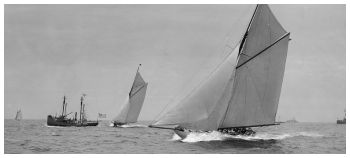 VIGILANT WON BY FORTY SECONDS. THE CUP CAN BE PUT BACK IN THE SAFE
VIGILANT WON BY FORTY SECONDS. THE CUP CAN BE PUT BACK IN THE SAFE Copyright © The New York Times - Published October 13, 1893
Copyright © The New York Times - Published October 13, 1893 
